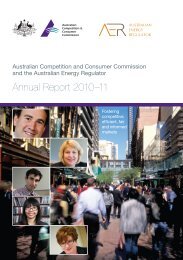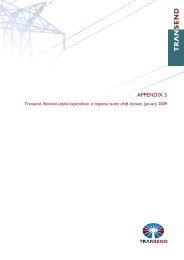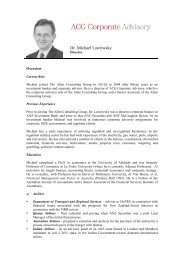Internal consistency of risk free rate and MRP in the CAPM
Internal consistency of risk free rate and MRP in the CAPM
Internal consistency of risk free rate and MRP in the CAPM
You also want an ePaper? Increase the reach of your titles
YUMPU automatically turns print PDFs into web optimized ePapers that Google loves.
176. This 12.36% estimate is higher than <strong>the</strong> 10.78% estimate derived immediately above.<br />
If one accepts that US regulators application <strong>of</strong> <strong>the</strong> DGM is unbiased <strong>and</strong> that US<br />
regulated bus<strong>in</strong>esses have similar underly<strong>in</strong>g <strong>risk</strong> to Australian regulated bus<strong>in</strong>esses<br />
<strong>the</strong>n this provides a basis for conclud<strong>in</strong>g that <strong>the</strong> 10.78% is more likely to be too low<br />
than too high.<br />
177. The estimates <strong>of</strong> <strong>the</strong> cost <strong>of</strong> equity derived under methodologies i) <strong>and</strong> ii) are 10.58%<br />
<strong>and</strong> 10.87% to 14.59% respectively. Once more, this suggests that <strong>the</strong> 10.78%<br />
estimate is more likely to be too low than too high. Depend<strong>in</strong>g on <strong>the</strong> threshold<br />
applied, one might, or might not, determ<strong>in</strong>e that <strong>the</strong> results <strong>of</strong> <strong>the</strong>se cross checks<br />
justified a departure from <strong>the</strong> estimate derived under methodology iii).<br />
7.4. Methodology iv)<br />
178. The fourth methodology is <strong>the</strong> AER’s methodology. This methodology fully reflects <strong>the</strong><br />
prevail<strong>in</strong>g <strong>risk</strong> <strong>free</strong> <strong>rate</strong> <strong>in</strong> <strong>the</strong> cost <strong>of</strong> equity but not <strong>the</strong> prevail<strong>in</strong>g <strong>risk</strong> premiums<br />
relative to that <strong>risk</strong> <strong>free</strong> <strong>rate</strong>. In <strong>the</strong> currently prevail<strong>in</strong>g market conditions this gives a<br />
materially downwardly biased estimate <strong>of</strong> <strong>the</strong> cost <strong>of</strong> equity because, for <strong>the</strong> reasons<br />
discussed <strong>in</strong> previous sections, it is clear that historically low CGS yields are currently<br />
associated with historically high <strong>risk</strong> premiums.<br />
7.4.1. Application<br />
179. This methodology arrives at a nom<strong>in</strong>al cost <strong>of</strong> equity estimate <strong>of</strong> 8.57% us<strong>in</strong>g end<br />
December 2011 CGS yields <strong>of</strong> 3.77%. This is materially lower than <strong>the</strong> estimate<br />
arrived at us<strong>in</strong>g all <strong>of</strong> <strong>the</strong> o<strong>the</strong>r methodologies.<br />
7.5. Summary <strong>of</strong> results from different methodologies<br />
180. Table 4 below summarises <strong>the</strong> results <strong>of</strong> <strong>the</strong> different methodologies.<br />
Competition Economists Group<br />
www.CEG-AP.COM<br />
47







